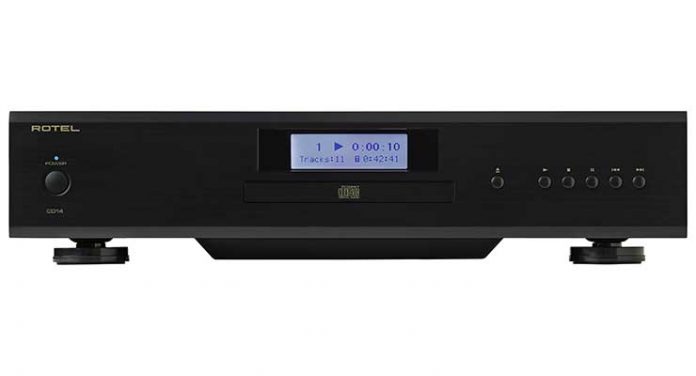For the past few years, there has been a steady stream of pronouncements that the Red Book audio disc format is on the ropes and headed for the tar pits of product extinction. Well, if 2015 CD sales numbers (exceeding 300 million units) are to be believed, the demise of this popular music source may have been somewhat exaggerated. The folks at Rotel are casting a vote for the future with the introduction of their newest CD player, the CD14.
[envira-album id=”93399″]
Set up
The façade of the CD14, available in silver or black, makes it readily recognizable as a member of the Rotel audio family. The front panel from left to right has a power button with an illuminated power status light, a disc tray surmounted by a display, and function buttons for eject, play, stop, pause, and track selection.
On the back, there is a pair of analog out RCA ports, an SPDIF digital output for an outboard DAC, RS-232 and Rotel Link ports, a 12V trigger input, and a 2-prong power receptacle.
The RR-D99 remote control unit is a bare bones unit with separate on/off buttons, central menu control buttons and a dimmer button, track selector buttons, and CD function buttons. At the bottom are the buttons for repeat track, programming, and time display. While installing this player into an audio system is pretty intuitive, a boon for tech-challenged neophytes, it is still worthwhile to read the concise owner’s manual so that the features like Rotel link, direct track access, track list programming, time display options and menu functions can be explained. The CD14 sports a Wolfson premium 24-bit/192kHz DAC, similar to the one in the new 14 series integrated amplifiers. Although this player can be connected to an outboard DAC, the presence of the Wolfson DAC would certainly reduce the need for (and the expense of) another component in the audio chain. Another deluxe feature is the specially designed power supply that delivers ripple-free voltage and current to digital and analog circuits. I should add that the CD14 can play mp3 files on a CD-ROM but, really, why bother with this low-res format (and I didn’t during this review).
Since the CD14 appears to be designed to mate with Rotel’s new 14 series integrated amplifiers I auditioned this player with the A12 model (reviewed separately) driving Totem Mani-2 Signature loudspeakers. Comparisons were made to my reference Oppo BDP-105 universal player; both units were connected to the RCA unbalanced inputs. Since the Oppo has an adjustable analog volume control, I dialed it in so that its output matched that of the CD14.
It Just Plays CDs
Red Book CDs played directly through the Oppo player’s ESS SABRE32 DAC were A/B’d with the same selections played through the Rotel’s Wolfson Premium DAC. A recent go-to CD track is Lise & Gertrud’s vocal duo/cello live rendition of “Eleanor Rigby.” The CD14 acquitted itself nicely on the interlacing female voices and the bowing of the accompanying cello. Another demo disc that I use often is Susan Nigro’s New Tunes for the Big Bassoon, an unusual recital of contemporary music for contrabassoon and piano. The details of the finger clicks on the keys and the resonance of the largest member of the woodwind family was just plain fun to hear.
An organ recital disc, Pipes of Rhode Island, presents challenges to any system that begins with the ability of the DAC to resolve the complex harmonics of the “King of Instruments.” J.S. Bach’s rollicking “Gigue Fugue” was a spectacular but, in the same vein, a very honest rendition of this organ tour de force. In a complete shift of gears, I went to a Delta Blues classic, Sonny Boy Williamson’s “Keep It To Ourselves,” a voice and harmonica cut, recorded in a Copenhagen hotel room in 1963. About midway through, Sonny Boy goes through a series of finger snaps changing in volume and location that sounded spot on through the CD14.
Comparisons with the Oppo BDP-105 were illuminating for what they did not reveal. If there were differences in what I heard with the same discs spun on each player, they were subtle at best and not reliably discerned on repeated listening. I probably should not have been surprised about these findings since there are numerous factors besides the DAC itself that determine the sound quality of a CD player.
The Final Assessment
Physical discs may no longer be the millennials’ first choice for accessing their music, but there are many music fans with large CD libraries and this format will hang around for a good while. Okay, the CD14 will not play high resolution SACDs, but although that format has been with us for more than 15 years, it has never gained a large following and most listeners may have few if any such discs. For those considering the purchase of a new CD player, particularly for the first time, the CD14 is a well-built and designed component that not only should last for a long time, but also may be the last CD player that they will ever need.
Specifications:
- Total Harmonic Distortion + Noise
- <0.002% at 1kHz
- Intermodulation Distortion
- <0.002% at 1kHz
- Frequency Response
- 20Hz-20kHz + 0.5 dB
- Channel Balance
- + 0.5 dB
- Phase Linearity
- + 0.5 degree
- Channel Separation
- >115 dB at 10kHz
- Signal-to-Noise Ratio
- > 118 dB
- Dynamic Range
- > 99 dB
- Analog Output Impedance
- 100 Ohms
- Digital Output
- 0.5 Volt peak-to-peak
- Load Impedance
- 75 Ohms
General
- Power Consumption
- 15 watts (<0.5 watts, standby)
- Power Requirements
- 120 volts, 60 Hz (USA version)
- 230 volts, 50 Hz (Europe version)
- Weight
- 5.9 kg (13 lbs)
- Dimensions (W x H x D)
- 430 x 93 x 312 mm
- 17 x 3.625 x 12.325 in
Be the first to leave a review.

